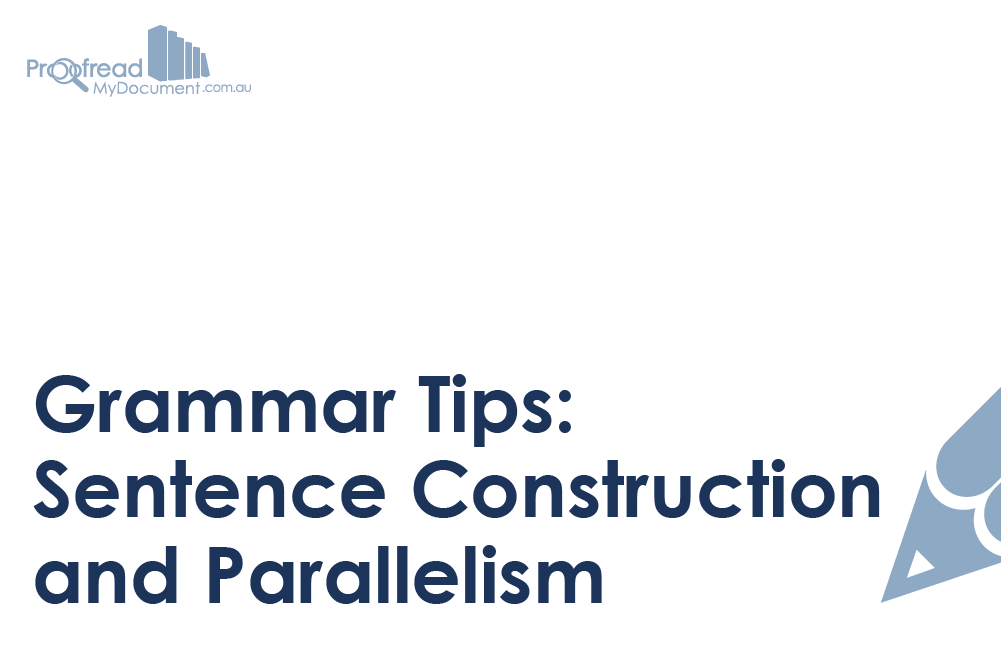One aspect of sentence construction that many writers get wrong is parallelism: i.e. the use of consistent grammatical structures throughout a sentence. Faulty parallelism, by comparison, occurs when different parts of a sentence are structurally imbalanced.
To make sure that your writing is grammatically correct, keep an eye out for sentences that are poorly constructed, such as in the following examples.
1. Verb Tense
One common mistake regarding parallelism is mixing up verb tenses. The sentence below, for instance, lacks parallelism:
Incorrect: Lauren takes a run up and jumped over the wall.
This is because ‘takes’ is a present tense verb and ‘jumped’ is the past tense. To ensure parallel construction, we would want to use two verbs of the same tense. It would thus have to be rewritten in either of the following ways:
Present Tense: Lauren takes a run up and jumps over the wall.
Past Tense: Lauren took a run up and jumped over the wall.
Both sentences use tense consistently, so they’re grammatically correct.
2. Infinitives and Gerunds
Another issue related to verb use is when the infinitive form (i.e. ‘to’ + verb) is combined with a gerund (i.e. an ‘-ing’ verb used as a noun). For example:
Incorrect: Duncan likes dancing and to sing.
Here, we’ve combined the gerund ‘dancing’ with the infinitive ‘to sing’. To correct this, we’d have to use one form consistently:
Gerunds: Duncan likes dancing and singing.
Infinitives: Duncan like to dance and to sing.
These sentences are fine, since the grammar is now parallel in both. It can be easy to miss this kind of error in lists, so it pays to be careful here.
3. Nouns, Adjectives and Adverbs
In descriptions, it’s good practice not to mix nouns, adjectives and adverbs. For example, the following sentence exhibits faulty parallelism:
Find this useful?
Subscribe to our newsletter and get writing tips from our editors straight to your inbox.
Incorrect: Previous techniques were expensive and a waste.
The problem here is that it combines an adjective (‘expensive’) and a noun (‘a waste’). A better construction would be to use two adjectives:
Correct: Previous techniques were expensive and wasteful.
The same need for consistency applies when modifying a verb:
Incorrect: Gloria sings sweetly and with great power.
Here, the adverb ‘sweetly’ is combined with a prepositional phrase containing a noun (‘with great power’). For a parallel construction, we could change it to:
Correct: Gloria sings sweetly and powerfully.
4. Plural and Singular Nouns
Sometimes, issues of parallelism arise because someone combines singular and plural nouns in a sentence. For example:
Incorrect: Side effects may include twitches or a headache.
In this case, we’ve combined the plural ‘twitches’ with the singular ‘headache’. But it would sound more natural to use the plural form for both words:
Correct: Side effects may include twitches or headaches.
However, it’s fine to combine a plural noun with an uncountable noun, even though the latter are typically treated as singular. For instance:
Correct: Side effects may include headaches or faintness.
This is acceptable since ‘faintness’ is an uncountable noun, so it wouldn’t make sense to write ‘faintnesses’. The most important factor, as ever, is whether the sentence is clear and sounds natural. But if you’re ever unsure about parallelism in your work, getting it proofread can help.



